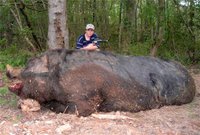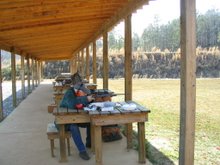Conceptual Basis
The paradox of the concealed personal defense weapon is that it is something you hope you will never have to use for its intended purpose, but with which you must achieve a level of mastery and familiarity comparable to the other tools you use to survive and get through your day. You wouldn't drive to work in a car that you didn't know how to operate. You wouldn't wear a coat that was three sizes too small or use a carpenter's saw to slice up a pot roast. No, you use the tools appropriate to the job and you learn how to work with them competently. The same holds true with a self defense pistol. You should know how to operate it and have the level of skill necessary to use it safely and effectively. It should fit your hand and your lifestyle because you will be spending a lot of time with it. It should be comfortable to shoot and hopefully to carry, although when asked if a carry gun should be comfortable to wear, master trainer Clint Smith said, "Your carry gun should be comforting, not comfortable." Your pistol should be powerful enough to do the job and accurate enough to hit the target. It should be completely reliable, and its operation should be as familiar to you as riding a bicycle or brushing your teeth. You must also have a clear understanding of the legal issues surrounding the use of deadly force -- when you can and when you can't -- and the methods and techniques of using a gun in a self defense situation. Sounds like a lot? You're right; it is, and if you are unwilling to master the skills and concepts of lethal force, do yourself a favor and just don't carry a gun. (See also The Psychology of Self Defense and the Force Continuum)
Skill and Familiarity
Handguns are not easy to shoot well. The ability to consistently put bullets into a target quickly and in the places which will stop an attacker is a skill that requires a lot of practice. Too many people have the notion that a pistol is a kind of magical talisman and the user need only take it out and wave it around and the problem will magically disappear. Nothing could be further from the truth. A gun brandished at the wrong time and without the fighting skills necessary to employ it effectively will make a whole bunch of new problems, including getting you killed or arrested and charged with some very serious crimes. Hence, making the decision to carry a gun should be made only with the commitment to practice and learn. This may take the shape of attending classes or participating in a practical shooting sport like IDPA. At the very least, a regular practice schedule should be part of the package. This means that you will be spending a lot of time with your pistol. The gun should be comfortable in your hand, have manageable recoil, and be sturdy enough to stand up to heavy use in practice sessions, matches, and classes. The gun should also have reasonable accuracy. You should be able to consistently put all of your shots in an area the size of a saucer at ten yards quickly.
Types and Sizes: Pros and Cons
When many folks think of a concealed carry gun, they think of little-bitty pocket pistols that will easily disappear into a pocket or purse. While these may be light and convenient, that's all they are. Aside from that, they're pretty useless. They lack the power to put down a determined attacker and they lack the accuracy to hit anything at more than spitting distance. But even more importantly, most little guns are unpleasant to shoot. Being very light and having small handles, their muzzle flip is very bad. After a few rounds your hand may begin to hurt. Shoot a match or take a class at Gunsite with one of these pocket guns? Forget it. If you don't learn to use it, how much good is it going to do you when the chips are down? In this group, I would include the small Berettas, Airweight snubnose revolvers, Seecamp .32's, Kel-Tek .32's and derringers. There may be a place for these pistols, but they all suffer from serious inadequacies. (I am particularly fond of the Airweight snubnose .38 Special revolver, but it can be an unpleasant gun to fire.)
Medium Frame Revolvers
Medium Frame Auto Pistols
Large Frame Pistols and Revolvers
Autoloader Action Types
Single Action - M1911 Colt .45 ACP and Browning Hi-Power 9mm
This is the oldest autoloader design still in service, designed by John Browning (with the help of the Army Ordnance Board) during the period between 1905 and 1911. The hammer must be cocked, generally by racking the slide, for the gun to fire. This design in .45 ACP, .40 S&W and .38 Super is favored by competitive shooters, FBI SWAT, FBI Hostage Rescue Team, and many special forces units because it has the best trigger, outstanding accuracy and is very fast. For the gun to be carried in a state of readiness, the hammer must be cocked and the manual safety applied, "cocked and locked" (see "The Conditions of Readiness"). This looks scary and is not recommended for novices or those suffering from attention deficit disorder.
Double Action/Single Action - Beretta 92F (Armed Forces M9), most Smith & Wesson autos, SIG, Walther, and some Rugers.
Double Action/Single Action with De-Cocker Only - Ruger and SIG
Double Action Only - Glock, Smith & Wesson Sigma, some Berettas, some Rugers, Kahr, Kel-Tec, and others.
Calibers and Power
I wouldn't be comfortable with anything smaller than a .380 (actually, I wouldn’t be comfortable with anything smaller than a .45 ACP, but that’s a different argument. See also Jim Higginbotham's "Case for the .45 ACP"). My personal favorite handgun cartridge is the .45 ACP because of its power and accuracy, but smaller cartridges will do the job if you do your part. Like the selection of the gun, the selection of a cartridge should be based on your ability to shoot it well. A good hit with a .380 is better than a miss with a .45. So, as a general rule, your self defense cartridge should be the largest and most powerful load that you shoot well.
The Selection Process
Consider how you dress and your lifestyle. How will you carry the pistol? Can you adjust your wardrobe to accommodate your pistol? Particular body shapes may present special problems. Your physical strength and conditioning may also be a factor, i.e., powerful auto pistols tend to function better for people with strong arms and hands. How much time do you have to devote to practice? As a rule of thumb, autos require more training than revolvers, so don't pick a single-action .45 auto if you're not willing to learn to use it.
Holsters
The selection of a holster which fits the gun you intend to carry is critically important. For a detailed discussion on this matter, click here.
Summary of Selection Criteria
- Your personal defense weapon should be as large and as powerful as you can shoot accurately and carry with a reasonable degree of comfort and concealment.
- Your personal defense weapon should fit your hand perfectly.
- You should be able to manipulate the controls of your weapon with either hand alone.
- Your personal defense weapon should be of sturdy construction and be able to withstand heavy use and rough handling.
- Your personal defense weapon should be accurate enough to consistently hit a target the size of a saucer at 10 yards quickly.
- Select the largest caliber you can shoot well, and a caliber for which ammunition is readily available.
- A good quality holster must be available for the model of pistol you intend to carry.
What Pistol Do I Carry? Click Here
Pistol Packin by Jim Higginbotham.
Concealed Carry and the 'Large' Auto Pistol by Jim Higginbotham.
Custom Auto Pistol Modifications for Serious Duty by Jim Higginbotham
Defensive Marksmanship by Jim Higginbotham
Handgun Power by Jim Higginbotham
Recommended Modifications to the Colt .45 Auto for Self-Defense Use by Les Bengtson
The Case for the .45 ACP by Jim Higginbotham
The Psychology of Self Defense and the Force Continuum by Syd











 On Monday the Senate bypassed the people and forced an Amnesty First bill to the floor. A select group of Senators will hold daily meetings starting Tuesday to determine whether proposed revisions would sink what they are calling their "grand bargain."
On Monday the Senate bypassed the people and forced an Amnesty First bill to the floor. A select group of Senators will hold daily meetings starting Tuesday to determine whether proposed revisions would sink what they are calling their "grand bargain." 


